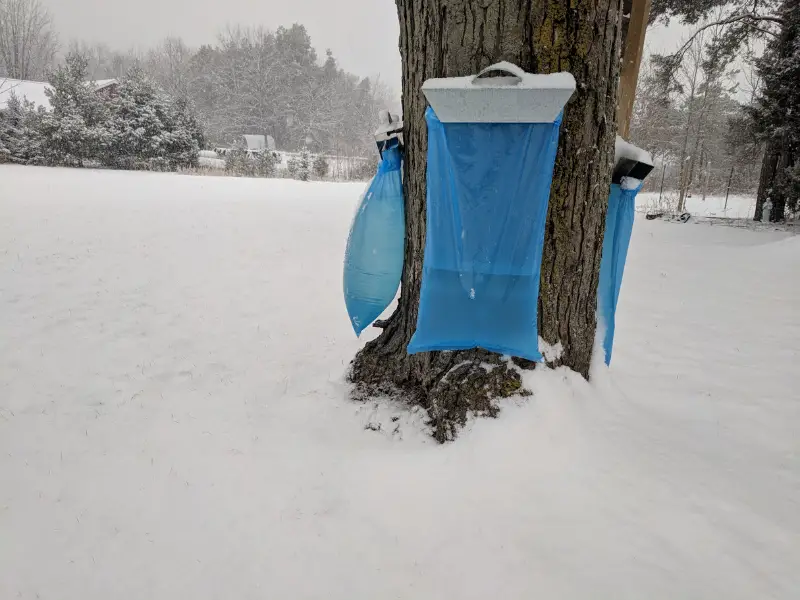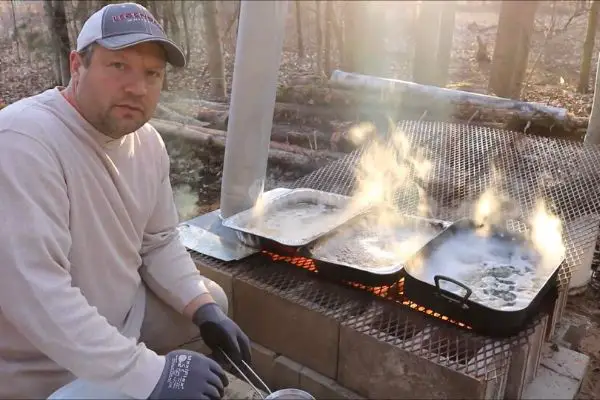Below is a list of frequently asked questions I get in the comments on my YouTube videos about making backyard maple syrup. These are questions that many beginners and those interested in trying their hand at making homemade maple syrup would likely ask. Some of these I’ve researched myself at one time or another and some I’ve learned from experience though years of making maple syrup from the trees right in my own backyard.
Keep in mind I live in Mid-Michigan so questions on timing may need to be adjusted to your locale.
How Often Can You Tap a Maple Tree?
Healthy maple trees can be tapped every year in late winter in preparation of the spring sap run. Depending on the size of the tree, it could have as many as 3 taps in it. A tree that shows signs of stress or damage should not be tapped but allowed to recover and regain health.
How Big Does a Maple Tree Have to Be to Tap It?
A maple tree should be 12″ inches in diameter (37-1/2″ circumference) before being tapped for the first time. I’ve seen some people claim you can tap them at 8″ but in my opinion that is just too small. That is a young tree that may not be fully established yet and tapping too soon may stress it out or severely slow it’s growth.
How Many Taps Can You Put in a Maple Tree?
The number of taps a healthy maple tree can handle without damage depends on the diameter of the tree. Here’s a handy chart showing the ratio of taps to tree diameter:
| 12″ – 20″ Diameter | 1 Tap |
| 20″ – 28″ Diameter | 2 Taps |
| Over 28″ Diameter | 3 Taps |
Can You Tap a Maple Tree Every Year?
Yes – as long as the tree is healthy it can tapped every year. If there were harsh conditions such as drought for the tree the previous year, it may be beneficial for the tree to skip being tapped for a year and allowed to recover.
When Should I Tap My Maple Trees?
Maple sap flows best when the daytime temps are above freezing and the night temperatures are below freezing. This generally occurs in February and runs into the middle of March. I have tapped my trees as early as the 3rd week in January when the temperatures were optimum for a week or so and got a great batch of early sap. If the weather gets cold again the sap will slow or stop for awhile until the temps are more favorable.
Can You Tap Maple Trees Too Early?
I feel that too early is anytime before January 1st. Once January hits and there’s a string of a few days when the temps get above freezing but drop back below freezing at night then my taps go in. I generally find that I get about 4 weeks of flow here in Michigan. If I tap in January I’ll probably be done by the end of February. As soon as the nights start staying above freezing I find that the sap starts to get cloudy and doesn’t produce the best syrup.
Should You Plug Maple Tap Holes?
You should not plug the tap hole on maple trees. The tree will heal that hole within months and inserting anything into it like a dowel or sticks will actually do more damage than good. By the middle of summer you will have a hard time even finding the tap hole from a few months earlier unless you really search for it.
When trees are tapped again the following spring, the new tap hole should be drilled 4″-6″ horizontally from last year’s hole. Also, tap holes should only be drilled to about 2″ deep to avoid damaging the tree.
Does Tapping Maple Trees Hurt Them?
Tapping maple trees for sap using best practices does not harm the tree. Drilling the tap hole will cause a small wound that quickly heals over and is nearly invisible by next spring when it’s time to tap again. The sap that runs in the tree contains sugar which the tree uses for nourishment to push out new buds and leaves, but by only tapping according to the taps/tree diameter chart above no harm is done.
Limiting the number of taps, using small diameter taps, and removing them in a timely fashion will ensure your maple trees stay healthy. If there are any signs that a tree is stressed or has been damaged in other ways then the tree should be allowed to recover for a season or more before being tapped again.
How Long Can You Leave a Tap in a Maple Tree?
Taps should be removed from your maple trees as soon as the sap run is over with. Taps are installed in January or February and removed when the season is over which will usually be sometime in late March or even as late as April in some areas. If a tap was left in all year, the hole will still close up and sap will not flow from that tap again.
Does Maple Sap Run at Night?
Generally, maple sap does not run at night. From my personal experience I’ve seen very little sap collected overnight, but occasionally depending on weather conditions such as a warm up to above freezing temperatures during the night some sap could flow.
I typically empty my collected sap into storage containers in the evening after work just before sundown. I’ve often checked in the morning to see if any more sap has been collected but very rarely there is. A nice sunny day will get them taps flowing again though.
How Much Sap can a Maple Tree Produce in One Day?
My largest maple tree is almost 30″ in diameter and gets 3 taps installed every year. On a good sap run day this tree can fill all three sap bags which equates to over 6 gallons of sap. The smallest tree that I tap is 12″ in diameter and gets only 1 tap. Last year was the first year I tapped this tree and on it’s best day it produced just over a gallon of sap.
Remember though this is a best day scenario. Some days the sap won’t run at all and others will be somewhere in between. For the entire season my big maple will probably produce close to 30 gallons of sap while the small 12″ tree will only produce 6-8 gallons.
Can You Drink Sap Straight From the Tree?
This one is somewhat controversial. I drink maple sap straight from the tap every year and I’ve never gotten sick. True there is a possibility it could contain harmful bacteria, but if you run a clean operation and only drink fresh sap that hasn’t been sitting around for days then those chances are slim enough for me to have a cup.
The North American native people drank maple sap and believed it revitalized and invigorated them just as the spring season renewed the earth. Analysis of maple sap has proven it to have many health beneficial compounds in it and “maple water” is becoming a new health drink. For all the benefits of drinking maple sap, I’ll refer you to this article from Wildfoodism.com which covers the subject very well.
How Much Maple Syrup Do You Get From 5 Gallons of Sap?
Maple sap contains between about 2% to 5% sugar. Most of the rest is water that must be evaporated or “boiled off”. On average, the ratio is 40 parts sap will yield 1 part syrup. If we convert gallons to pints, 5 gallons will equal 40 pints. So with the 40:1 ratio, 5 gallons of sap will yield 1 pint of finished maple syrup.
Using this ratio, 10 gallons of sap will produce 1 quart of maple syrup and 20 gallons will leave you with 1/2 gallon of finished maple syrup on average.
How Long Do You Have to Boil Sap to Make Syrup?
How long it takes to boil down your maple sap into syrup takes several factors into account:
- The fuel source and how much of it you use
- The efficiency of your evaporator
- The surface area of your evaporator pans
- The amount of sap you have to boil
I can tell you from my experience that to boil 20 gallons of sap down to about 1 gallon over a wood fire in 3 roasting pans takes about 4 hours – give or take a half hour either way depending on how hot I keep the fire.
How Much Energy is Needed to Make Maple Syrup?
Let’s first state some basic thermodynamic rules:
- To raise the temperature of 1 lb. of water 1 degree takes one BTU
- To convert 1 lb. of 212 degree water to steam takes 970 BTUs
- A gallon of water weighs 8.34 lbs.
- A gallon of propane has 91,500 BTUs
- One face cord of maple of oak firewood contains 8 million BTUs
In this example we’ll say we have 40 gallons of sap to boil down to 1 gallon of finished syrup. The sap is a 35 degrees to start the process.
- 40 x 8.34 = 333.6 lbs of water
- 212 – 35 = 177 degrees to bring to boil
- 333.6 x 177 = 59,047.2 BTUs of energy to bring to boil
- 325.3 x 970 = 315,541 BTUs of energy to convert 39 gallons to steam
- 315,541 + 59,047.2 = 374,588 BTUs of total energy needed
All this math tells us that it takes about 375,000 BTUs of energy to make one gallon of maple syrup. That would be about four gallons of propane or about 1/20 of a face cord of wood. HOLD ON though, that is assuming a 100% efficient evaporator system where all the heat is transferred to the sap. A homemade concrete block evaporator I’m guessing is only about 10-20% efficient so that means it will take closer to a 1/4 or 1/2 face cord of hardwood.
Commercial evaporators average around 75% which makes for a much more efficient use of fuel. Still with that efficiency using propane, a gallon of syrup would require over 5 gallons of propane at $3/gallon which adds $15 to the cost of producing each gallon of maple syrup.
Can I Boil Sap in My House?
The short answer is NO. The longer answer is still no except for the finishing process where 99% of the water has been evaporated already. The nearly finished sap is finished over the stove where it can be monitored more closely. Even doing this you will probably notice condensation forming on your windows. Imagine if you converted gallons of sap into steam how moist the air in your house would be and the damage it could cause.
Using a turkey fryer outside is the next easiest option for the beginner maple syrup maker although it is not very cost effective using propane as the fuel source. Yet it is a great way to get started. Check out the video from my YouTube channel below:
How Long Will Maple Sap Last?
I normally keep my sap for no more than one week before evaporating. This is because I typically boil down on a weekend when I have all day for the process. I collect sap all week and keep it sealed in 5-gallon food-grade buckets in a snow bank or in my shed assuming the weather stays cold.
I have kept some sap in gallon jugs in the refrigerator for a couple weeks and it was fine. This was sap from a test tap early in the season which didn’t leave me with enough to start boiling down. As the weather warms the sap itself starts to become cloudy at which point it doesn’t seem to last very long and it gets harder to store at cool temps so that’s when I start to pull my taps.
Do Other Trees Make Syrup?
In addition to just about all species of maple trees that are used for syrup, there are several others that can be tapped. These include box elder, black walnut, butternut, and birch. The sugar content is lower than maples in these other species which makes it more costly to produce which is why you don’t typically see any syrup from these trees available for sale.
I have not personally tasted the syrup from these other varieties, but I’ve heard all of them have a uniquely different flavor than maple syrup but still pretty tasty. If ever I find someone with a stand of black walnut that would let me tap them I’ll find out for myself.
What is a Maple Tree Tap Called?
A spile is the traditional term for the device used to tap maple trees. Spiles were originally made from a hollowed tube of reed or wood by native peoples. As new settlers began tapping trees, metal spiles were produced. Most had hooks for hanging pails to collect the sap. Today many commercial producers use plastic spiles, but metal ones are still widely available and some people even use the traditional methods of using wood spiles.




